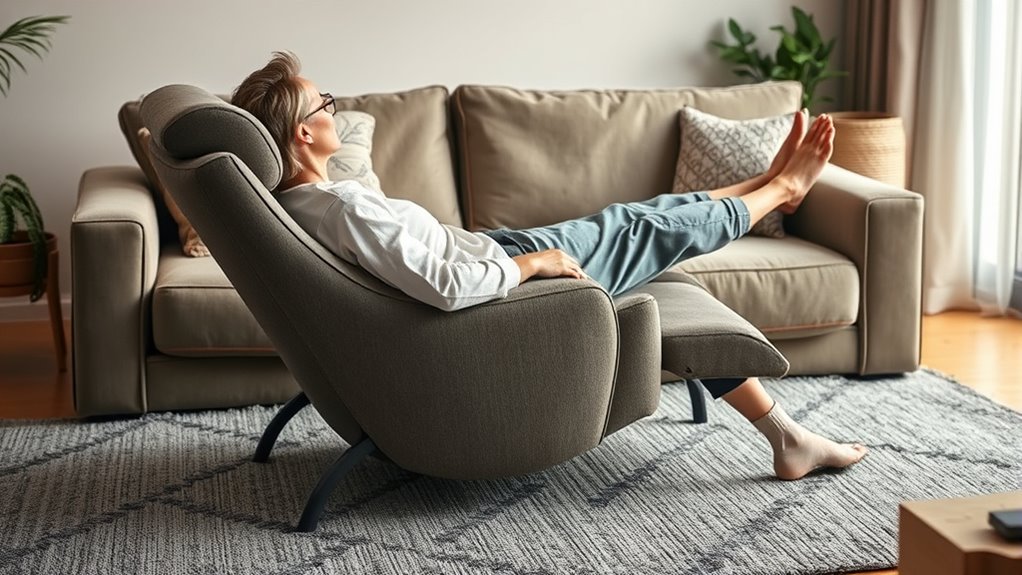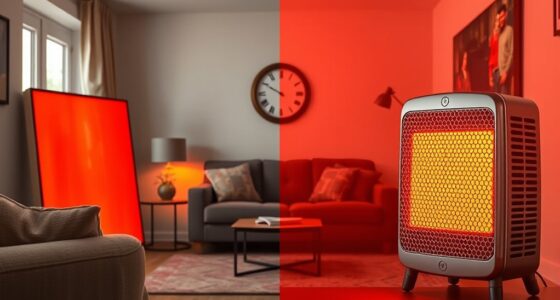To protect your spine as a couch potato, sit with a slight recline between 100-110 degrees. This angle evenly distributes your weight, reducing pressure on your lumbar discs and maintaining natural lower back curves. Use lumbar support for added comfort, and keep your feet flat on the floor with knees at a 90-degree angle. Remember, small adjustments can make a big difference, so explore more tips for ideal sitting posture to stay comfortable longer.
Key Takeaways
- Maintain a slight recline of 100-110 degrees to evenly distribute weight and reduce lumbar pressure.
- Use adjustable lumbar support to support natural lower back curves during extended sitting.
- Ensure your seat height allows feet to rest flat on the floor with knees at a 90-degree angle.
- Slightly elevate hips above knees to promote proper posture and spinal alignment.
- Take regular breaks to stand, stretch, and adjust seating angles for ongoing spinal protection.

Maintaining the right seating angle is essential for protecting your spine, especially if you spend long hours sitting. When you sit correctly, you reduce pressure on your lumbar region, preventing discomfort and long-term issues. One of the most effective ways to achieve this is by choosing a chair with proper lumbar support. Lumbar support helps maintain the natural curve of your lower back, preventing slouching and reducing strain on spinal discs. When the support fits well, it encourages you to sit upright, promoting better posture throughout your sitting sessions.
Proper lumbar support maintains natural lower back curves, reduces slouching, and promotes healthier posture during long sitting sessions.
In addition to lumbar support, an adjustable height feature is crucial. Your chair should allow you to set the seat height so that your feet rest flat on the floor, with your knees at a 90-degree angle. This positioning minimizes stress on your lower back and hips, keeping your spine aligned. When your chair’s height is adjustable, you can customize it to fit your body perfectly, ensuring your hips are slightly higher than your knees. This slight elevation encourages an open angle at your hips, which is vital for maintaining proper spinal alignment.
The ideal seating angle works hand-in-hand with these adjustable features. A slight recline—around 100 to 110 degrees—can help distribute your weight more evenly across your pelvis and lower back. This angle reduces pressure on your lumbar discs and keeps your spine in a neutral position. Sitting completely upright all the time can cause tension, but a gentle recline combined with lumbar support creates a more relaxed posture that’s easier to sustain for extended periods.
It’s important to remember that even the most supportive and adjustable chair isn’t enough if you don’t pay attention to your sitting habits. Take regular breaks to stand, stretch, and move around. Adjust your chair’s height and lumbar support if you feel discomfort, and ensure your feet stay flat on the ground. Keep your shoulders relaxed and your back supported against the chair’s backrest. Small adjustments can make a big difference in preventing strain and maintaining spinal health. Being aware of ergonomic seating angles can further help you optimize your sitting posture for long-term comfort.
Frequently Asked Questions
How Often Should I Change My Sitting Position?
You should change your sitting position every 30 to 60 minutes to prevent strain and promote good circulation. Incorporate proper sitting habits and use ergonomic accessories like supportive cushions or adjustable chairs to maintain spinal health. Regularly shifting your posture helps you avoid stiffness and discomfort. Remember, staying mindful of your sitting habits and making small adjustments can make a big difference in protecting your spine over time.
What Are Signs of Poor Ergonomic Seating?
You notice poor ergonomic seating when you experience discomfort, frequent aches, or numbness during or after sitting. Your posture may look hunched or uneven, signaling a need for posture correction. Using ergonomic accessories like lumbar supports or adjustable chairs can help. If you find yourself slouching or leaning excessively, it’s a clear sign to improve your seating setup to protect your spine and promote better comfort and health.
Can Ergonomic Chairs Prevent Back Pain Entirely?
You might think ergonomic chairs prevent back pain completely, but that’s a myth. While good office chair features, like adjustable lumbar support and seat height, can reduce discomfort, they won’t eliminate all issues. Ergonomic chair myths often lead you to believe pain won’t happen, but maintaining good posture and taking breaks are equally important. Using the right chair helps, but it’s just one part of preventing back pain.
Are There Specific Cushions That Enhance Spinal Health?
You might find that specific cushions can truly boost your spinal health. Look for cushions with adjustable firmness to suit your comfort, and prioritize those with good lumbar support to maintain proper posture. These features help reduce pressure on your spine and prevent pain. By choosing the right cushion, you actively support your back during long sitting periods, making it easier to stay comfortable and healthy throughout the day.
How Does Posture Impact Long-Term Spine Health?
Your posture is the superhero guarding your spine’s future! Poor posture can cause long-term damage faster than a speeding bullet, leading to chronic pain or misalignment. By practicing posture correction and engaging in ergonomic training, you strengthen your spine’s resilience. Consistently maintaining good posture reduces stress on your vertebrae and discs, promoting long-term health. You’ll feel more comfortable, energized, and less prone to injuries, making your spine a true champion for years to come.
Conclusion
By choosing the right seating angles, you’re not just sitting—you’re transforming your spine into an invincible fortress. Imagine every minute spent on your couch as a shield against pain, a fortress guarding your posture from the relentless assault of gravity. So, sit smart, angle wisely, and let your couch become the ultimate sanctuary where your spine reigns supreme—untouchable, unbreakable, and forever protected. Your back will thank you with a lifetime of comfort and resilience.









